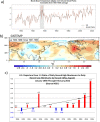How the Great Plains Dust Bowl drought spread heat extremes around the Northern Hemisphere
- PMID: 36253425
- PMCID: PMC9576710
- DOI: 10.1038/s41598-022-22262-5
How the Great Plains Dust Bowl drought spread heat extremes around the Northern Hemisphere
Abstract
Extraordinary heat extremes occurred in the 1930s in areas of the Northern Hemisphere far from the record setting heat over the US associated with the Great Plains Dust Bowl drought. A climate model sensitivity experiment is used to identify a new mechanism involving a warm season circumglobal atmospheric teleconnection pattern that spread heat extremes over far-flung areas of the Northern Hemisphere arising from the intense heating over the desiccated Great Plains themselves. It has only been in the twenty-first century that human populations in these regions of the Northern Hemisphere have experienced heat extremes comparable to the 1930s. This demonstrates that humans influenced Northern Hemisphere temperature and heat extremes through disastrous and unprecedented regional land use practices over the Great Plains, and points to the possibility that future intense regional droughts could affect heat extremes on hemispheric scales.
© 2022. The Author(s).
Conflict of interest statement
The authors declare no competing interests.
Figures




References
-
- Egan T. The Worst Hard Time. Boston: Houghton Mifflin Company; 2006.
-
- Schubert S, et al. A USCLIVAR project to assess and compare the responses of global climate models to drought-related SST forcing patterns: Overview and results. J. Clim. 2009;22:5251–5272. doi: 10.1175/2009JCLI3060.1. - DOI
-
- Herweijer C, Seager R. The global footprint of persistent extra-tropical drought in the instrumental era. Int. J. Climatol. 2008 doi: 10.1002/joc.1590. - DOI
-
- Donat MG, et al. Extraordinary heat during the 1930s dust bowl and associated large-scale conditions. Clim. Dyn. 2016;46:413–426. doi: 10.1007/s00382-015-2590-5. - DOI
Publication types
MeSH terms
Substances
LinkOut - more resources
Full Text Sources

